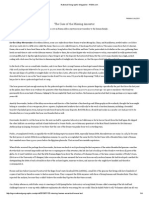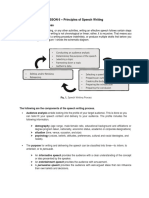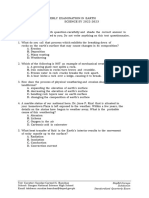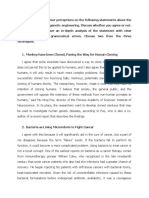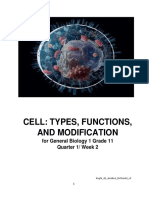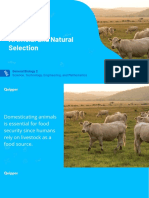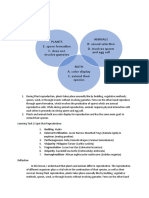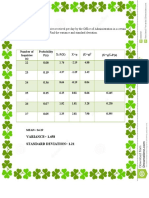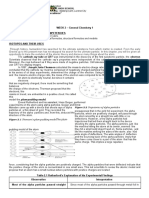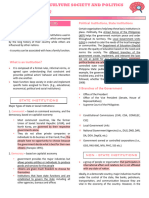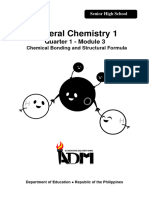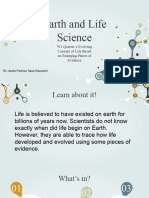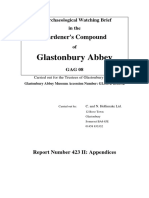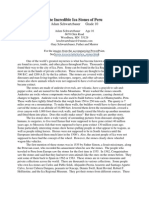Rev01 - Q2.ESS MELC 12
Uploaded by
jiamail gampongRev01 - Q2.ESS MELC 12
Uploaded by
jiamail gampongEarth Science
Quarter 2 – Module 12:
Describe How Index Fossils (also
known as guide fossils) are used to
define and identify subdivisions of
the Geologic Time Scale
Earth Science
Alternative Delivery Mode
Quarter 2 – Module 12: Title
First Edition, 2020
Republic Act 8293, section 176 states that: No copyright shall subsist in any work
of the Government of the Philippines. However, prior approval of the government agency or
office wherein the work is created shall be necessary for exploitation of such work for profit.
Such agency or office may, among other things, impose as a condition the payment of
royalties.
Borrowed materials (i.e., songs, stories, poems, pictures, photos, brand names,
trademarks, etc.) included in this module are owned by their respective copyright holders.
Every effort has been exerted to locate and seek permission to use these materials from
their respective copyright owners. The publisher and authors do not represent nor claim
ownership over them.
Published by the Department of Education
Secretary: Leonor Magtolis Briones
Undersecretary: Diosdado M. San Antonio
Development Team of the Module
Writers: Anastacio F Mendizabal Jr.
Editors: Ferdinand M. de Castro Reviewers: Mark
Anthony Lagumen Illustrator: Lallie C. Buensalida
Layout Artist: Annaliza Q. Avilles, Rosanito S. Paras
Management Team: Wilfredo E. Cabral, Regional Director
Job S. Zape Jr., CLMD Chief
Elaine T. Balaogan, Regional ADM Coordinator
Fe M. Ong-ongowan, Regional Librarian
Printed in the Philippines by
Department of Education – Region IV-A CALABARZON
Office Address: Gate 2 Karangalan Village, Barangay San Isidro
Cainta, Rizal 1800
Telefax: 02-8682-5773/8684-4914/8647-7487
E-mail Address: [email protected]
Earth Science
Quarter 2 – Module 1:
History of the Earth
Introductory Message
For the facilitator:
Welcome to the (Earth Science Grade 11 STEM) Alternative Delivery Mode
(ADM) Module on (How index fossils also known as guide fossils are used to define
and identify subdivisions of geologic time scale ) !
This module was collaboratively designed, developed and reviewed by educators
both from public and private institutions to assist you, the teacher or facilitator in
helping the learners meet the standards set by the K to 12 Curriculum while
overcoming their personal, social, and economic constraints in schooling.
This learning resource hopes to engage the learners into guided and independent
learning activities at their own pace and time. Furthermore, this also aims to help
learners acquire the needed 21st century skills while taking into consideration
their needs and circumstances.
In addition to the material in the main text, you will also see this box in the body of
the module:
Notes to the Teacher
This contains helpful tips or strategies
that will help you in guiding the learners.
As a facilitator you are expected to orient the learners on how to use this module.
You also need to keep track of the learners' progress while allowing them to
manage their own learning. Furthermore, you are expected to encourage and assist
the learners as they do the tasks included in the module.
ii
For the learner:
Welcome to the Earth Science Alternative Delivery Mode (ADM) Module on (How
index fossils also known as guide fossils are used to define and identify
subdivisions of geologic time scale) !
The hand is one of the most symbolized part of the human body. It is often used to
depict skill, action and purpose. Through our hands we may learn, create and
accomplish. Hence, the hand in this learning resource signifies that you as a
learner is capable and empowered to successfully achieve the relevant
competencies and skills at your own pace and time. Your academic success lies in
your own hands!
This module was designed to provide you with fun and meaningful opportunities
for guided and independent learning at your own pace and time. You will be
enabled to process the contents of the learning resource while being an active
learner.
This module has the following parts and corresponding icons:
What I Need to Know This will give you an idea of the skills or
competencies you are expected to learn in
the module.
What I Know This part includes an activity that aims to
check what you already know about the
lesson to take. If you get all the answers
correct (100%), you may decide to skip this
module.
What’s In This is a brief drill or review to help you link
the current lesson with the previous one.
What’s New In this portion, the new lesson will be
introduced to you in various ways such as a
story, a song, a poem, a problem opener, an
activity or a situation.
What is It This section provides a brief discussion of
the lesson. This aims to help you discover
and understand new concepts and skills.
What’s More This comprises activities for independent
practice to solidify your understanding and
skills of the topic. You may check the
answers to the exercises using the Answer
Key at the end of the module.
What I Have Learned This includes questions or blank
sentence/paragraph to be filled in to
iii
process what you learned from the lesson.
What I Can Do This section provides an activity which will
help you transfer your new knowledge or
skill into real life situations or concerns.
Assessment This is a task which aims to evaluate your
level of mastery in achieving the learning
competency.
Additional Activities In this portion, another activity will be given
to you to enrich your knowledge or skill of
the lesson learned. This also tends retention
of learned concepts.
Answer Key This contains answers to all activities in the
module.
At the end of this module you will also find:
References This is a list of all sources used in
developing this module.
The following are some reminders in using this module:
1. Use the module with care. Do not put unnecessary mark/s on any part of
the module. Use a separate sheet of paper in answering the exercises.
2. Don’t forget to answer What I Know before moving on to the other activities
included in the module.
3. Read the instruction carefully before doing each task.
4. Observe honesty and integrity in doing the tasks and checking your
answers.
5. Finish the task at hand before proceeding to the next.
6. Return this module to your teacher/facilitator once you are through with it.
If you encounter any difficulty in answering the tasks in this module, do not
hesitate to consult your teacher or facilitator. Always bear in mind that you are
not alone.
We hope that through this material, you will experience meaningful learning
and gain deep understanding of the relevant competencies. You can do it!
iv
What I Need to Know
This module was written and intended for Grade 11 STEM students. It is here to
help you accustomed with how index fossils (also known as guide fossils are used
to define and identify subdivisions of geologic time scale. This module helps you to
applied it in many different learning situations. The vocabulary level of students
was the basis of the language used on this module. The lessons are arranged to
follow the standard order of the course. But the sequence in which you read
The module is divided into three lessons, namely:
Lesson 1 – What is index fossils?
Lesson 2 – History of Earth’s Life Forms
Lesson 3 – How Index Fossils Help Define Geologic Time Scale?
After going through this module, you are expected to:
1. define what is index fossils or guide fossils.
2. define subdivisions of geologic time scale.
3. list down the different subdivisions of geologic time scales.
4. identify how index fossils are used to described subdivisions of geologic time
scale.
5. explain why it is rare for an organism to be preserved as a fossil.
6. distinguish between body fossils and trace fossils.
7. describe five types of fossilization.
8. explain the importance of index fossils, and give several examples.
9. describe what a living fossil is.
10. explain how the fossil record shows us that species evolve over time.
11. describe the general development of Earth’s life forms over the last 540
million years.
1
What I Know
Choose the letter of the best answer. Write the chosen letter on a separate sheet of
paper.
1. What is the correct definition of index fossils?
a. Remnants of the living things
b. Remnants of the non-living things
c. Remnants of the planets and stars
d. Remnants of the universe
2. What fossils are formed through petrification?
a. Molds etrified c. Cast
b. Trace
3. What subdivision of geologic time characterized by the differences in life-
forms?
a. Period c. Eons.
b. Epoch d. Eras
4. On what era do we belong today?
a. Cenozoic c. Paleozoic
b. Mesozoic d. Proterozoic
5. How many percent that a Precambrian takes up the history of the earth?
a. 60% c. 80%
b. 70% d. 90%
6. The Greeks named them ammonites after the ram god.
a. Rah. c. Ahmed
b. Kareb d. Ammon
7. Which creatures whose bones became fossilized with a wingspan of up to 12
meters (39 feet)?
a. dinosaur Argentinosaurus c. Protoceratops
b. pterosaur Quetzalcoatlus d. Griffin
8. Index fossils formed by the preserved remains of specific species found in the
strata of
a. sedimentary rock c. Metamorphic rock
b. igneous rock d. magma rock
2
9. Charles Walcott discovered this bizarre animal with five eyes lived during the
Cambrian.
a. Silurian c. Cambrian
b. Devonian d. Ordovician
10. The living fossils are organisms that have existed for a tremendously long
period of time without changing very much, the example that have existed
from the Cambrian period to the present is
a. Lingulata brachiopods
b. Archaeopteryx
c. Anomalocaris
d. Ammonite
11. Which of the following is not considered as criteria of an index fossils?
a. The fossilized organism must be easily recognizable.
b. The fossils have to be geographically widespread.
c. The fossil must have lived for only a short time.
d. The fossil must have lived for only a long time.
12. The process of a once living organism becoming a fossil is called
a. microfossils. c. index fossils.
b. fossilization. d. living fossils.
13. The term Phanerozoic means
a. “time of unwell-displayed life”.
b. “time of well-displayed life”.
c. “time of well-un played life”.
d. “time of well- replayed life”.
14. The largest mass extinction in Earth history occurred at the end of the
a. Precambrian period, about 250 million years ago.
b. Phanerozoic period, about 250 million years ago
c. Permian period, about 250 million years ago
d. Archean period, about 250 million years ago
15. First mammals on Earth was seen during Mesozoic era, how many million
years ago?
a. 130 c. 200
b. 150 d. 251
3
Lesson
Earth Science:
1 What is Index Fossils
Fossils
Throughout human history, people have discovered fossils and wondered
about the creatures that lived long ago. The griffin, a mythical creature with a lion’s
body and an eagle’s head and wings, was probably based on skeletons
of Protoceratops that were discovered by nomads in Central Asia (Figure 11.1).
Another fossil reminded the Greeks of the coiled horns of a ram. The Greeks
named them ammonites after the ram god Ammon. Similarly, legends of the
Cyclops may be based on fossilized elephant skulls found in Crete and other
Mediterranean islands. Can you see why (Figure 11.2)?
Figure 11.2: Ammonite (left) and elephant skull (right). The giant
pterosaur Quetzalcoatlus had a wingspan of up to 12 meters (39 feet). The
dinosaur Argentinosaurus had an estimated weight of 80,000 kg, equal to the
weight of seven elephants! Other fossils, such as the trilobite and ammonite,
impress us with their bizarre forms and delicate beauty.
Figure 11.3: Kolihapeltis (left) and Ammonite (right).
Clues from Fossils
Fossils are our best form of evidence about the history of life on Earth. In
addition, fossils can give us clues about past climates, the motions of plates, and
other major geological events.
The first clue that fossils can give is whether an environment
was marine (underwater) or terrestrial (on land). Along with the rock
characteristics, fossils can indicate whether the water was shallow or deep, and
whether the rate of sedimentation was slow or rapid.
Fossils can also reveal clues about past climate. For example, fossils of
plants and coal beds have been found in Antarctica. Although Antarctica is frozen
today, in the past it must have been much warmer.
4
How are index fossils formed?
Index fossils are the preserved remains of specific species found in the strata of
sedimentary rock. They are easily recognized by shape and lived for either a short
period of time, geologically speaking, or completely vanished from the Earth in a
known extinction event. Index fossils are usually sea creatures due to preservation
conditions and how widespread ocean-dwelling creatures can proliferate on the
planet.
Types of Fossils
Fossilization can occur in many ways. Most fossils are preserved in one of five
processes; preserved remains, permineralization, molds and casts, replacement,
and compression.
1. Preserved Remains
The rarest form of fossilization is the preservation of original skeletal material and
even soft tissue. For example, insects have been preserved perfectly in amber,
which is ancient tree sap. Several mammoths and even a Neanderthal hunter have
been discovered frozen in glaciers.
2. Permineralization
The most common method of fossilization is permineralization. After a bone, wood
fragment, or shell is buried in sediment, it may be exposed to mineral-rich water
that moves through the sediment. This water will deposit minerals into empty
spaces, producing a fossil. Fossil dinosaur bones, petrified wood, and many marine
fossils were formed by permineralization.
3. Molds and Casts
In some cases, the original bone or shell dissolves away, leaving behind an empty
space in the shape of the shell or bone. This depression is called a mold. Later the
space may be filled with other sediments to form a matching cast in the shape of
the original organism. Many mollusks (clams, snails, octopi and squid) are
commonly found as molds and casts because their shells dissolve easily.
4. Replacement
In some cases, the original shell or bone dissolves away and is replaced by a
different mineral. For example, shells that were originally calcite may be replaced
by dolomite, quartz, or pyrite. If quartz fossils are surrounded by a calcite matrix,
the calcite can be dissolved away by acid, leaving behind an exquisitely preserved
quartz fossil.
5. Compression
Some fossils form when their remains are compressed by high pressure. This can
leave behind a dark imprint of the fossil. Compression is most common for fossils
of leaves and ferns, but can occur with other organisms, as well.
Figure 11.6: Five types of fossils: insect preserved in amber, petrified wood, cast
and mold of a clam shell, compression fossil of a fern and pyritized ammonite.
5
Exceptional Preservation
Some rock beds have produced exceptional fossils. Fossils from these beds may
show evidence of soft body parts that are not normally preserved. Two of the most
famous examples of soft organism preservation are the Burgess Shale in Canada
and the Solnhofen Limestone in Germany.
Figure 11.7: Fossils from Lagerstätten: Archaeopteryx (left)
and Anomalocaris (right). Archaeopteryx was an early bird. Anomalocaris was an
enormous predator (one-meter-long) that lived 500 million years ago.
Index Fossils and Living Fossils
Index fossils, are widespread but only existed for a relatively brief period of time.
When a particular index fossil is found, the relative age of the bed is immediately
known.
Ammonites, trilobites, and graptolites are often used as index fossils, as are
various microfossils, or fossils of microscopic organisms.
Living fossils are organisms that have existed for a tremendously long period of
time without changing very much at all. For example, the Lingulata brachiopods
have existed from the Cambrian period to the present, a time span of over 500
million years!
Figure 11.8: Fossil Lingula (left) and modern Lingula (right).
Correlation by Index Fossils
To be considered an index fossil, it must meet 3 criteria:
1. The fossilized organism must be easily recognizable. It must be easy to ID and
look unique.
2. The fossils have to be geographically widespread, or found over large areas so
that we can use them to match layers separated by huge distances.
3. The fossil must have lived for only a short time, so that it appears in only
horizontal layer of sedimentary rocks
For example:
The diagram below shows several rock
out crops separated by large distances.
In each out crop are several fossils.
Which of the fossils shown is an index
fossil?
6
When choosing the right index fossil we can reinterpret the characteristics of index
fossil to help us as stated above: To find the index fossil you must eliminate any
fossils that don’t show up in each rock outcrop and those that show up in more
than one layer per outcrop.
We can eliminate “fossil 1” because it
shows up in multiple layers in the
same outcrop. (It lived for too long of a
time period in Earth’s history to help
establish dates of other rocks).
We can eliminate “fossil 2” because it
shows up in multiple layers in column
2. (It lived for too long a time period).
We can eliminate “fossil 3” because t
is only in one layer in one outcrop.
After we've eliminated all the fossils
that don't fit the requirements, we
have only 1 left that appears in all the
outcrops, and in only one layer per
outcrop. So the correct index fossil is:
Using Index Fossils to Correlate
Rock Layer
We can use index fossils and key beds
to correlate, or match rock layers that
are the same age. By doing this we
can then place other layers of rocks in
order of their relative ages to find the
oldest and youngest rocks in a series
of outcrops. For Example: Examine
the outcrop below and determine
which layers are the oldest and
youngest.
To find the oldest and youngest layers in the entire diagram, we first have to
correlate the three outcrops. We can do this by using the trilobite index fossil,
because it appears in all three outcrops.
By correlating them, we now know that layers A, K, and Q are the same age. So to
find the oldest rocks we look below them, and to find the youngest rocks we look
above them. If we create a chart building our way up and down by looking directly
above and below each layer we will find the top and bottom.
7
Lesson
Earth Science: History of
2 Earth’s Life Forms
Charles Doolittle Walcott.
He was a paleontologist, which is a
scientist who studies past life on
Earth. He was searching for fossils.
Riding on horseback, he was making
his way down a mountain trail when
he noticed something on the ground.
He stopped to pick it up. It was a
fossil! One of the organisms preserved
in the fossils had a soft body like a
worm, five eyes, and a long nose like a
vacuum cleaner hose (Figure 12.16).
Most of the fossils were the remains of
animals that do not live today. They
are now extinct, which means that
nothing of their kind lives and that
they are gone forever.
Figure 12.16
The organisms in Walcott’s fossils lived during a time of geologic history known as
the Cambrian. The Cambrian period began about 540 million years ago. It marked
the beginning of the Phanerozoic Eon. It also marked the beginning of many new
and complex life forms appearing on Earth. In fact, the term Phanerozoic means
“time of well-displayed life”. We still live today in the Phanerozoic Eon. However, life
on Earth is very different today than it was 540 million years ago.
Earth’s Diversity
Figure 12.17: There is an amazing diversity of organisms on Earth.
There are over 1 million species of plants and animals known to be currently alive
on Earth (Figure 12.17). Look around you and you notice that the organisms on
this planet have incredible variation. One of the most remarkable features of
Earth’s organisms is their ability to survive in their specific environments.
For example, polar bears have thick
fur coats that help them stay warm in
the icy waters that they hunt in
(Figure 12.18)
Figure 12.18
8
Other organisms have special features that help them hunt for food or avoid being
the food of another organism. For example, when zebras in a herd run away from
lions, the zebras’ dark stripes confuse the lions and make it hard for them to focus
on just one zebra during the chase. Hummingbirds have long thin beaks that help
them drink nectar from flowers. Some plants have poisonous or foul-tasting
substances in them that keep animals from eating them.
Adaptations and Evolution
The characteristics of an organism
that help it survive in a given
environment are called adaptations.
Adaptations develop when certain
variations in a population help some
members survive better than others
(Figure 12.19). Often the variation
comes from a mutation, or a random
change in an organism’s genes. The
ones that survive pass favorable traits
on to their offspring. Figure 12.19
Changes and adaptations in a species accumulate over time. Eventually the
descendants are very different from their ancestors and may become a whole new
species. Changes in a species over time are called evolution. It shows us that many
of the life forms that live today developed from earlier, different life forms.
For example, horse fossils show us
that about 60 million years ago horses
were much smaller than they are
today (Figure 12.20). Fossils also
show us that horses’ teeth and hooves
have changed several times as horses
have adapted to changes in the
environment Figure 12.20
Studying the Fossil Record
Like the organisms that were represented in Walcott’s fossils, many of the
organisms that once lived on Earth are now extinct. Earth’s overall environmental
conditions have changed many times since the Cambrian, and many organisms did
not have the traits to survive the changes. Those that did survive the changes
passed traits on to their offspring. They gave rise to the species that live today.
We study fossils to learn about how species responded to change over the Earth’s
long history. Fossils show us that simple organisms dominated life on Earth for its
first 3 billion years. Then, between 1 and 2 billion years ago, the first multi-cellular
organisms appeared on Earth. Life forms gradually evolved and became more
complex. During the Cambrian period, animals became more diverse and complex.
Phanerozoic Eon
The Phanerozoic Eon is divided into three chunks of time called eras—the
Paleozoic, the Mesozoic, and the Cenozoic (Table (12.1). They span from about 540
million years ago to the present. We live now in the Cenozoic Era.
9
The table below shows how life has changed during the long span of the
Phanerozoic Eon. Notice that different types of organisms developed at different
times. However, all organisms evolved from a common ancestor. Life gradually
became more diverse and new species branched out from that common ancestor.
Most modern organisms evolved from species that are now extinct.
Era Millions of Years Ago Major Forms of Life
Cenozoic 0.2 (200,000 years ago) First humans
35 First grasses; grasslands
begin to dominate the land
Mesozoic 130 First plants with flowers
150 First birds on Earth
200 First mammals on Earth
251 Age of dinosaurs begins
300 First reptiles on Earth
360 First amphibians on Earth
Paleozoic 400 First insects on Earth
475 First reptiles on Earth
500 First amphibians on Earth
Table 12.1: Development of Life During the Phanerozoic Eon
The eras of the Phanerozoic Eon are separated by events called mass extinctions. A
mass extinction occurs when large numbers of organisms become extinct in a short
amount of time. Between the Paleozoic and the Mesozoic, nearly 95% of all species
on Earth died off.
Between the Mesozoic and the Cenozoic, about 50% of all animal species on Earth
died off. This mass extinction, 65 million years ago, is the one in which the
dinosaurs became extinct.
Earth’s climate changed numerous
times during the Phanerozoic Eon.
Just before the beginning of the
Phanerozoic, much of the Earth was
cold and covered with glaciers (Figure
12.21). As the Phanerozoic began, Figure 12.21:
however, the climate was changing to
a warm and tropical one (Figure
12.22). The glaciers were replaced
with tropical seas. This allowed the
Cambrian Explosion of many new life
forms on Earth. During the
Phanerozoic, Earth’s climate has gone
through at least 4 major cycles
between times of cold glaciers and Figure 12.22
times of warm tropical seas.
10
Earth Science:
Lesson
How Index Fossils Help
3
Define Geologic Time?
Geologic Time
The first principle you need to understand about geologic time is that the laws of
nature are always the same. This means that the laws describing how things work
are the same today as they were billions of years ago. For example, water freezes at
0°C. This law has always been true and always will be true. Knowing the natural
laws helps you think about Earth’s past, because it gives you clues about how
things happened very long ago. It means that we can use present-day processes to
interpret the past. Imagine you find fossils of sea animals in a rock. That law has
never changed, so the rock must have formed near the sea. The rock may be
millions of years old, but the fossils in it are a clue for us today about how it
formed.
Now imagine that you find that same rock with fossils of a sea animal in a place
that is very dry and nowhere near the sea. How could that be? Remember that the
laws of nature never change. Therefore, the fossil means that the rock definitely
formed by the sea. This tells you that even though the area is now dry, it must have
once been underwater. Clues like this have helped scientists learn that Earth’s
surface features have changed many times. Spots that were once covered by warm
seas may now be cool and dry. Places that now have tall mountains may have once
been low, flat ground. The place where you live right now may look very different in
the far future.
Every fossil tells us something about the age of the rock it's found in, and index
fossils are the ones that tell us the most. Index fossils (also called key fossils or
type fossils) are those that are used to define periods of geologic time.
Characteristics of an Index Fossil
A good index fossil is one with four characteristics: it is distinctive, widespread,
abundant, and limited in geologic time. Because most fossil-bearing rocks formed
in the ocean, the major index fossils are marine organisms.
Boom-And-Bust Organisms
Any type of organism can be distinctive, but not so many are widespread. Many
important index fossils are of organisms that start life as floating eggs and infant
stages, which allowed them to populate the world using ocean currents. The most
successful of these became abundant, yet at the same time, they became the most
vulnerable to environmental change and extinction.
Trilobites, Hard-Shelled Invertebrates
Consider trilobites, a very good index fossil for Paleozoic rocks that lived in all parts
of the ocean. Trilobites were constantly evolving new species during their existence,
which lasted 270 million years from Middle Cambrian time to the end of the
Permian Period, or almost the entire length of the Paleozoic. Because they were
mobile animals, they tended to inhabit large, even global areas.
11
They were also hard-shelled invertebrates, so they fossilized easily. These fossils
are large enough to study without a microscope.
Small or Microscopic Fossils
Other major index fossils are small or microscopic, part of the floating plankton in
the world ocean. These are handy because of their small size. They can be found
even in small bits of rock, such as wellbore cuttings. Because their tiny bodies
rained down all over the ocean, they can be found in all kinds of rocks.
Terrestrial Rocks
For terrestrial rocks, which form on land, regional or continental index fossils may
include small rodents that evolve quickly, as well as larger animals that have wide
geographic ranges. These form the basis of provincial time divisions.
Defining Ages, Epochs, Periods, and Eras
Index fossils are used in the formal architecture of geologic time for defining the
ages, epochs, periods, and eras of the geologic time scale. Some of the boundaries
of these subdivisions are defined by mass extinction events, like the Permian-
Triassic extinction. The evidence for these events is found in the fossil record
wherever there is a disappearance of major groups of species within a geologically
short amount of time.
Geologic Time Scale
Today, the geologic time scale is divided into major chunks of time called eons.
Eons may be further divided into smaller chunks called eras, and each era is
divided into periods. We now live in the Phanerozoic eon, the Cenozoic era, and the
Quarternary period. Sometimes, periods are further divided into epochs, but they
are usually just named “early” or “late”, for example, “late Jurassic”, or “early
Cretaceous”. Note that chunks of geologic time are not divided into equal numbers
of years. Instead, they are divided into blocks of time when the fossil record shows
that there were similar organisms on Earth.
One of the first scientists to understand geologic time was James Hutton. In the
late 1700s, he traveled around Great Britain and studied sedimentary rocks and
their fossils. He believed that the same processes that work on Earth today formed
the rocks and fossils from the past. He knew that these processes take a very long
time, so the rocks must have formed over millions of years. He is sometimes called
the “father of geology”.
Figure 12.2 shows you a different way
of looking at the geologic time scale. It
shows how Earth’s environment and
life forms have changed.
12
What’s In
Activity 1: Launch Lab: Survival Through Time
Environments include the living and non-living things that surround and affect
organisms. Whether or not an organism survives in its environment depends upon
its characteristic. Only if an organism survives until adulthood can it produce and
pass on its characteristics to its offspring. In this lab, you will use a model to find
out how one characteristic can determine whether the individuals can survive in an
environment.
1. Cut 15 pieces each of green, orange and blue yarn into 3-cm lengths.
2. Scatter them on a sheet of green construction paper.
3. Have your partners (mother or siblings) use a pair of tweezers to pick up as
many pieces as possible in 15 seconds.
4. Think Critically: Which colors your partner selected? Which color least selected?
Suppose that the construction paper represents grass, the yarn pieces represent
insects, and the tweezers represent an insect-eating bird. Which color of insect
do you predict would survive to adulthood?
Notes to the Teacher
Hello dear teachers, this module maybe used by learners with
minimal supervision. The activities included are suitable for their
level and capacity. Make sure that the learners had finished the
previous modules. Thank you.
13
What’s New
Activity 1: Reading Check
Material: Article about Index fossils
Directions: Read the articles about Index fossils to identify subdivision of geologic
and answer the activity below.
A fossil is the remain or evidences of a living thing. The most common fossils are bones,
skills, teeth, leaves, spores and seeds of pollen grains. Most fossils are formed when the
whole part of an organism becomes buried in sedimentary rocks, which provide the
most important evidence about the evolution of plants and animals. Fossils give clues
about organisms that lived long ago. They also provide evidence about how Earth’s
surface changed overtime. Fossils helps scientist understand what past environments
may have been like.
There are five main types of fossils namely: 1!) Petrified fossils are formed through
petrification that means turning into stones.it forms when minerals replace all part of
an organism. (2) Molds and casts, molds forms when hard parts of an organism are
buried in sediments such as sand, silt, or clay, a cast is forms as the result of mold.
Minerals and sediments fills the mold’s empty spaces and make a cast. (3) Carbon
Films, all living things contain an element called carbon. When an organism dies and is
buried in sediments, the material that make up the organism break down. Eventually,
only carbon remains. (4) Trace fossils show the activities of organism. An animal makes
a footprint when it steps in sand or mud. Overtime the footprint is buried in layers of
sediment, then sediment becomes solid rock. (5) Preserved remains, some organisms get
preserved in or close to their original states. There are some ways it can happen;(a)
Amber-an organism, such as insect, is trapped in a tree’s sticky resins and dies. (b) Tar-
an organism, such as mammoth, is trapped in a tar pit and dies. (c) Ice-an organism,
such as wooly mammoth, dies in very cold regions.
Geologic time is divided into four large segments called Eons: Hadean, Archean,
Proterozoic, and Phanerozoic. The Phanerozoic Eon (the eon of visible life) is divided into
Eras: The names of the eras are the Cenozoic ("recent life"), Mesozoic ("middle life") and
Paleozoic ("ancient life"). The longest geologic era was the Precambrian. It began with
the formation of the earth about 4.53 billion years ago, and ended about 542 million
years ago. So the Precambrian takes up about 90% of the history of the earth.
Next to eons, the longest subdivisions are the eras, which marked by major, striking,
and worldwide changes in the types of fossils present. Eras are subdivided into periods.
Periods are units of geologic time characterized by the types of life existing worldwide at
the time. Period can be divided into smaller units of time called epochs. Epochs also are
characterized by the differences in life-forms, but some of these differences vary from
continent to continent. Epochs of period in the Cenozoic era have been given specific
names. Epochs of other periods usually are referred to simply as early, middle, or late.
Epochs are subdivided into units of shorter duration called system.
14
Assessment 1: Discussion/Analysis
1. How do fossils are formed?
2. How do index fossils help scientist to understand the past?
3. Which type of fossil contain carbon?
4. Which is the longest subdivisions of geologic time scale?
5. How long is Precambrian era?
Assessment 2: Elaborate
Directions: Arrange the major subdivisions of geologic time scale by choosing the
right option beside the illustration.
Geologic Epochs
Time
Major
System Eras
Subdivision
of Geologic
Time
Eons Periods
Assessment 3: Appraise- Match the types of index fossils in Column A with
their description in column B.
COLUMN A COLUMN B
A. Some organisms get preserved in or
1. PERTIFIED FOSSIL
close to original states
B. All living things contain an element
2. MOLDS AND CAST
called carbon.
C. Minerals and sediments that are left
3. CARBON FILMS
in the mold make a cast
D. When minerals replace all or part of
4. TRACE FOSSILS
an organism.
E. An animal makes a footprint when it
5. PRESERVED REMAINS
steps in sand or mud.
15
What is It
A fossil is any remains of ancient life. Fossils can be body fossils, which are
remains of the organism itself or trace fossils, such as burrows, tracks, or other
evidence of activity.
Preservation as a fossil is a relatively rare process. The chances of becoming a
fossil are enhanced by quick burial and the presence of preservable hard parts,
such as bones or shells.
Fossils form in five ways: preservation of original remains, permineralization,
molds and casts, replacement, and compression.
Rock formations with exceptional fossils are called very important for scientists
to study. They allow us to see information about organisms that we may not
otherwise ever know.
Index fossils are fossils that are widespread but only existed for a short period of
time. Index fossils help scientists to find the relative age of a rock layer and
match it up with other rock layers.
Living fossils are organisms that haven’t changed much in millions of years and
are still alive today.
Fossils give clues about the history of life on Earth, environments, climate,
movement of plates, and other events.
Adaptations are favorable traits that organisms inherit. Adaptations develop from
variations within a population and help organisms to survive in their given
environment.
Changes in populations accumulate over time; this is called evolution.
The fossil record shows us that present day life forms evolved from earlier
different life forms. It shows us that the first organisms on Earth were simple
bacteria that dominated the Earth for several billion years.
Beginning about 540 million years ago more complex organisms developed on
Earth. During the Phanerozoic Eon all of the plant and animal types we know
today have evolved.
Many types of organisms that once lived are now extinct. Earth’s overall
environment, especially the climate, has changed many times, and organisms
change too over time.
16
What’s More
Activity 1: Identifying an index fossil:
Directions: Let’s find the index fossil in Figure 1 which shows 4 outcrops separated
by large distances. (An outcrop is section of Earth’s layers from a particular area
Let’s revisit the 4 criteria to help us: 1. Easily Recognizable 2. Widespread3. Short
Lived 4. abundant
1. Was Fossil #1 the index fossil?
Why: It was not the index fossil because it was not ;
this means it did not show up in all the .
2. Was Fossil #2 the index fossil?
Why: It was not the index fossil because it was not
; this means it showed up in more than one
in an outcrop.
3. Was Fossil #3 the index fossil?
Why: It was and ; It was in
column and in each column it was in on
row.
4. Was Fossil #4 the index fossil?
Why: It was not the index fossil because it was not
; this means it showed up in more than one
17
What I Have Learned
Assessment 1: “Fill Me Up”
Directions: Filled up the blank and choose your answer on the box provided. Write
your answer on separate paper.
preserved remains past climates sedimentary rock
motions of plates permineralization replacement
molds and casts major geological events Compression
microfossils Living fossils must be easily recognizable
adaptations Fossilization lived for only a short time
mass extinction variation geographically widespread
1. Fossils are our best form of evidence about the history of life on Earth, in
addition, fossils can give us clues about ,
, and .
2. Index fossils are the preserved remains of specific species found in the strata
of .
3. Most fossils are preserved in one of five processes; ,
, , and ,
.
4. Ammonites, trilobites, and graptolites are often used as index fossils, as are
various , or fossils of microscopic organisms.
5. are organisms that have existed for a tremendously
long period of time without changing very much at all.
6. To be considered an index fossil, it must meet 3 criteria: The fossilized
organism
(1).
(2).
(3).
7. The process of a once living organism becoming a fossil is
called .
8. An amazing diversity of organisms on Earth and it is called as
.
9. The characteristics of an organism that help it survive in a given
environment are called .
10. The eras of the Phanerozoic Eon are separated by events called
.
18
Assessment 2: “Vocabulary Words to Remember!”
Directions: Arrange the following jumble vocabulary words. Write your answer on
separate paper.
1. B E R A M
Fossilized tree sap.
2. S O F L I S
Any remains or trace of an ancient organism.
3. A T O R I C P L
A climate that is warm and humid.
4. T A C S
A structure that forms when sediments fill a mold and harden, forming a
replica of the original structure.
5. E A R I N M
Of or belonging to the sea.
6. D O L M
An impression made in sediments by the hard parts of an organism.
7. C R E T A L O S F S I
Evidence of the activity of an ancient organism. Examples include tracks,
trails, burrows, tubes, boreholes, and bite marks.
8. L I A R S E R E T R I L A S
Of or belonging to the land
9. L A C I G E R S
Large sheets of flowing ice.
10. LENSTAOOLOGPIT
A scientist who studies Earth’s past life forms.
19
What I Can Do
Activity 1: Identifying index fossil
Directions: Since we only have one outcrop, we do not need to worry about the
criteria of being widespread. We do need to look at the criteria of being short lived
which means the index fossil will be found in one layer(s).
1. Which layer(s) contain fossil A?
2. Which layer(s) contain fossil B?
3. Which layer(s) contain fossil C?
4. Which layer(s) contain fossil D?
5. Which layer(s) contain fossil E?
6. Which layer(s) contain fossil F?
7. Therefore the index fossil is fossil
.
8. The longest lived fossil was fossil
because it was found in layers.
9. Determine the relative age of the
fossils:
(youngest fossil)
(oldest fossil)
20
Assessment
Multiple Choice. Choose the letter of the best answer. Write the chosen letter on a
separate sheet of paper.
1. What are the common fossils?
a. Bones and teeth c. Options A and B are correct
b. Spores and seeds d. Options A and B are incorrect
2. What type of preserved fossils is trapped in a tree’s sticky resins and dies?
a. Amber c. Ice
b. Tar d. Wood
3. Which Era represent “ancient life.”
a. Cenozoic c. Paleozoic
b. Mesozoic d. Proterozoic
4. When was the Precambrian Era begin?
a. 4.53 billion years ago c. 4.55 billion years ago
b. 4.54 billion years ago d. 4.56 billion years ago
5. What is the shorter unit of Epochs?
a. Period c. System
b. Time d. Eon
6. A good index fossil must include one with four characteristics except for
a. distinctive. c. abundant.
b. widespread. d. long live.
7. Another name for index fossil.
a. Key fossils c. Lead fossils
b. Pattern fossils d. Design fossils
8. Sometimes called the “father of geology”.
a. Charles Darwin c. James Hutton.
b. Charles Doolittle Walcott d. James Ingram
9. When an organism completely dies out.
a. Adaptation c. Evolution
b. Extinction d. Regeneration
21
10. Which of the following statement is correct about Geologic Time Scale?
a. It is divided into major chunks of time called Eras. Eras may be
further divided into smaller chunks called eons, and each eons is
divided into periods.
b. It is divided into major chunks of time called eons. Eons may be
further divided into smaller chunks called eras, and each era is
divided into periods.
c. It is divided into major chunks of time called periods. Periods may
be further divided into smaller chunks called eras, and each era is
divided into eons.
d. It is divided into major chunks of time called eras. Eras may be
further divided into smaller chunks called period, and each periods
is divided into eons.
11. Which of the following represents the longest time period?
a. Precambrian c. Mesozoic
b. Paleozoic d. Cenozoic
12. Fossils are most common in which rock types?
a. sedimentary
b. igneous
c. metamorphic
d. all of these commonly contain fossils
13. Which of the following will not make a fossil?
a. animal footprints
b. loose animal bones
c. plant impressions (casts)
d. decomposed organic material
14. Most periods in the geologic time scale are named for .
a. geographic localities c. paleontologists
b. catastrophic events d. fossils
15. Human beings evolved during which geologic era?
a. Cenozoic c. Paleozoic
b. Mesozoic d. Precambrian
22
Additional Activities
Worksheets
A. Fossils and Ancient Life
For Questions 1–3, complete each statement by writing the correct word or words.
1. Species that died out are said to be .
2. Most fossils are found in layers of rock .
3. Scientists who study fossils are called .
4. What is the fossil record?
5. What information does the fossil record provide?
6. Fill in the flowchart to explain how fossils are formed.
The preserved fossil remains maybe later be
discovered and studied.
B. Dating Earth’s History
7. What is an index fossil? What do index fossils reveal about other material
found with them?
8. Fossil A is found in a layer of rock above a layer containing Fossil B. Which
fossil is probably older? Explain your answer.
9. List the two techniques paleontologists use to determine the age of fossils.
23
What I Know What's More Assessment
1. A 1. No, widespread, 1. C
2. B outcrops/colum 2. A
3. A ns 3. C
4. C 2. No, short lived, 4. A
5. A layer/row 5. C
6. D 3. Yes, widespread 6. D
7. B and short lived, 7. A
8. A every, one 8. C
9. C 4. No, short lived, 9. B
10.A layer/row 10.B
11.D 11.A
12.B What I can Do 12.A
13.A 13.D
14.C 1. 2, 3 14.A
15.C 2. 5 15.A
3. 3. 4. 5. 6
4. 1, 2
5. 6, 7, 8
6. 8, 9, 10
7. B
8. C, 4
9. F, E, B, C, A, D
References
Books
Earth and Life Science for Senior High School (Core Subject). Copyright,
2016 By Lorimar Publishing, Inc. 776 Aurora Boulevard, corner Boston Street,
Cubao Quezon City, Metro Manila, Philippines.
Online Reference
Science Online bluemsscience.com
https://en.wikipedia.org/wiki/List_of_index_fossils
https://sciencing.com/describe-types-fossils-8147260.html
https://www.rowan.k12.ky.us/userfiles/994/Classes/1493/Index%20Fossil%20Characteristics%20an
d%20Correlation.pdf
https://www.thoughtco.com/what-are-index-fossils-1440839
https://courses.lumenlearning.com/earthscience/chapter/geologic-time-scale/
25
For inquiries or feedback, please write or call:
Department of Education - Bureau of Learning Resources (DepEd-BLR)
Ground Floor, Bonifacio Bldg., DepEd Complex
Meralco Avenue, Pasig City, Philippines 1600
Telefax: (632) 8634-1072; 8634-1054; 8631-4985
Email Address: [email protected] * [email protected]
You might also like
- National Geographic Magazine - The Case of The Missing AncestorNo ratings yetNational Geographic Magazine - The Case of The Missing Ancestor4 pages
- 821-051-73 Explanatory Note of Geological Map Ethiopia50% (2)821-051-73 Explanatory Note of Geological Map Ethiopia85 pages
- Big Book of Patterns Grs. 1-5 (1) - NoRestriction PDF100% (3)Big Book of Patterns Grs. 1-5 (1) - NoRestriction PDF209 pages
- Earth Science Q2 Week 6 - REFINED - EDITEDNo ratings yetEarth Science Q2 Week 6 - REFINED - EDITED12 pages
- Test Curator: Sundae Carmel S. Basubas School: Siargao National Science High School Email Address: Sundae - Basubas@deped - Gov.phNo ratings yetTest Curator: Sundae Carmel S. Basubas School: Siargao National Science High School Email Address: Sundae - Basubas@deped - Gov.ph13 pages
- Current Technology in Genetic EngineeringNo ratings yetCurrent Technology in Genetic Engineering2 pages
- Earth Science: Quarter 2 - Week 5: Formation of Stratified Rocks Relative and Absolute DatingNo ratings yetEarth Science: Quarter 2 - Week 5: Formation of Stratified Rocks Relative and Absolute Dating19 pages
- What I Know: Directions: Read and Analyze The Following Questions. Choose The LetterNo ratings yetWhat I Know: Directions: Read and Analyze The Following Questions. Choose The Letter12 pages
- ELS-Final-Module - 10-08082020 (1) - 022953No ratings yetELS-Final-Module - 10-08082020 (1) - 02295326 pages
- Modular Activity IN Research 1: (Week 1-4)No ratings yetModular Activity IN Research 1: (Week 1-4)30 pages
- 1 1 Shs Ga Las Week 2 Reading and Writing Finish OreoNo ratings yet1 1 Shs Ga Las Week 2 Reading and Writing Finish Oreo10 pages
- Author: Diana Rose C. Chua School/Station: Cecilia National High School Division: Deped - Agusan Del Sur Email AddressNo ratings yetAuthor: Diana Rose C. Chua School/Station: Cecilia National High School Division: Deped - Agusan Del Sur Email Address7 pages
- Lesson10: Inverse of One - To-One FunctionsNo ratings yetLesson10: Inverse of One - To-One Functions36 pages
- Earth Life Science Quarter 1 Module 1 PDFNo ratings yetEarth Life Science Quarter 1 Module 1 PDF41 pages
- Understanding Culture, Society and Politics (UCSP)No ratings yetUnderstanding Culture, Society and Politics (UCSP)20 pages
- SHS Earth and Life Science - QUARTER 2 Module 5 ColoredNo ratings yetSHS Earth and Life Science - QUARTER 2 Module 5 Colored25 pages
- FINAL (PS) - PR1 11 - 12 - UNIT 5 - LESSON 4 - Designing Instruments For Data CollectionNo ratings yetFINAL (PS) - PR1 11 - 12 - UNIT 5 - LESSON 4 - Designing Instruments For Data Collection31 pages
- Activity 1: Pre-Test: Louise Joseph G. Peralta Grade 11-Fairness100% (2)Activity 1: Pre-Test: Louise Joseph G. Peralta Grade 11-Fairness4 pages
- Plants E. Spore Formation F. Does Not Involve Gametes Animals B. Sexual Selection D. Involves Sperm and Egg CellNo ratings yetPlants E. Spore Formation F. Does Not Involve Gametes Animals B. Sexual Selection D. Involves Sperm and Egg Cell5 pages
- GeneralChemistry1 Q1 Mod3 Chemical-Bonding-and-Structural-Formula Version5No ratings yetGeneralChemistry1 Q1 Mod3 Chemical-Bonding-and-Structural-Formula Version528 pages
- Physical Education and Health: Active For LifeNo ratings yetPhysical Education and Health: Active For Life18 pages
- PDF General Biology 2 Reviewer 4th Quarter - CompressNo ratings yetPDF General Biology 2 Reviewer 4th Quarter - Compress23 pages
- PDF Practice Makes Perfect Advanced English Reading and Comprehension Download100% (8)PDF Practice Makes Perfect Advanced English Reading and Comprehension Download24 pages
- Download full The First Fossil Hunters Dinosaurs Mammoths and Myth in Greek and Roman Times Adrienne Mayor ebook all chaptersNo ratings yetDownload full The First Fossil Hunters Dinosaurs Mammoths and Myth in Greek and Roman Times Adrienne Mayor ebook all chapters67 pages
- G6 ELA ReleasedItems ResearchSimulationTask-ItemSet Final - pdf-Video+StudentNo ratings yetG6 ELA ReleasedItems ResearchSimulationTask-ItemSet Final - pdf-Video+Student17 pages
- STD.12 HSC Board Question - Bank - Geology - Eng MedNo ratings yetSTD.12 HSC Board Question - Bank - Geology - Eng Med21 pages
- heredity-and-evolution-chapter-assessment-science-and-technology-part-2-std-10th-english-medium15720183081642660677No ratings yetheredity-and-evolution-chapter-assessment-science-and-technology-part-2-std-10th-english-medium157201830816426606772 pages
- The Human Lineage 2nd Edition Matt Cartmill Fred H Smith download100% (1)The Human Lineage 2nd Edition Matt Cartmill Fred H Smith download77 pages
- Bradley&Hanson1998 - Paleoslope Analysis of Slump Folds in The Devonian Flysch of MaineNo ratings yetBradley&Hanson1998 - Paleoslope Analysis of Slump Folds in The Devonian Flysch of Maine15 pages
- Cretaceous Orogenic Granite Belts, KALIMANTAN INDONESIANo ratings yetCretaceous Orogenic Granite Belts, KALIMANTAN INDONESIA22 pages
- To Trace Back The Evolutionary History of Homo Sapiens SapiensNo ratings yetTo Trace Back The Evolutionary History of Homo Sapiens Sapiens15 pages
